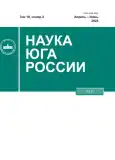НЕФТЯНЫЕ КОМПОНЕНТЫ В ВОДЕ И ДОННЫХ ОТЛОЖЕНИЯХ РЕКИ ТЕМЕРНИК
- Авторы: Барабашин Т.О1, Экилик В.С1, Павленко Л.Ф1, Скрыпник Г.В1
-
Учреждения:
- Всероссийский научно-исследовательский институт рыбного хозяйства и океанографии, Азово-Черноморский филиал
- Выпуск: Том 19, № 2 (2023)
- Страницы: 53-60
- Раздел: Статьи
- URL: https://journals.eco-vector.com/2500-0640/article/view/627585
- DOI: https://doi.org/10.7868/S25000640230207
- ID: 627585
Цитировать
Полный текст
Аннотация
В р. Темерник в пределах г. Ростова-на-Дону в воде и донных отложениях отмечен высокий уровень загрязнения нефтепродуктами и полициклическими ароматическими углеводородами. Наиболее загрязнены участки реки в районе рынка «Темерник», Змиевской балки, Ботанического сада Южного федерального университета, автовокзала и устья. Превышение ПДК нефтепродуктов обнаружено более чем в 80 % проанализированных проб воды. Кратность превышения ПДК в воде варьировала от 0,4 до 82,8 раза. В подавляющем большинстве проанализированных проб воды р. Темерник результаты люминесцентного метода в 1,3‒13 раз превышали результаты инфракрасного метода, что свидетельствует о накоплении стойких к процессам деградации люминесцирующих полициклических ароматических углеводородов. Полученные данные свидетельствуют о хроническом характере нефтяного загрязнения воды р. Темерник на участке от рынка «Темерник» до устья. В донных отложениях реки концентрации нефтепродуктов варьировали от сотых долей (0,04 г/кг) до аномально высоких значений (200 г/кг сухой массы). Согласно усредненным данным, полученным в различные сезоны 2018‒2020 гг., по увеличению нефтяного загрязнения донных отложений участки р. Темерник располагаются в следующем порядке: Ростовское море, Верхнее водохранилище, Верхнее водохранилище 2, Камышеваха, Нижнее водохранилище, Сурб Хач, автовокзал, рынок «Темерник», Змиевская балка, Ботанический сад, устье. Концентрации суммы полициклических ароматических углеводородов в воде различных участков р. Темерник менялись в пределах 91,6‒505,6 нг/л, в донных отложениях – 277,6‒2939 мкг/кг сухой массы. Максимальные их концентрации в воде и в донных отложениях обнаружены в районе автовокзала. Превышения предельно допустимой концентрации нафталина (4000 нг/л) и бенз(а)пирена (10 нг/л) в исследованных пробах воды не обнаружено. В составе полициклических ароматических углеводородов в воде доминировал нафталин, в донных отложениях – флуорантен.
Ключевые слова
Об авторах
Т. О Барабашин
Всероссийский научно-исследовательский институт рыбного хозяйства и океанографии, Азово-Черноморский филиал
Email: timbar@bk.ru
Российская Федерация, 344002, г. Ростов-на-Дону
В. С Экилик
Всероссийский научно-исследовательский институт рыбного хозяйства и океанографии, Азово-Черноморский филиалРоссийская Федерация, 344002, г. Ростов-на-Дону
Л. Ф Павленко
Всероссийский научно-исследовательский институт рыбного хозяйства и океанографии, Азово-Черноморский филиалРоссийская Федерация, 344002, г. Ростов-на-Дону
Г. В Скрыпник
Всероссийский научно-исследовательский институт рыбного хозяйства и океанографии, Азово-Черноморский филиалРоссийская Федерация, 344002, г. Ростов-на-Дону
Список литературы
- Прядко М.П., Голеусов П.В. 2011. Особенности трансформации гидрохимического режима функционирования малых городских рек. Проблемы региональной экологии. 2: 36‒40.
- Никаноров А.М., Хоружая Т.А., Минина Л.И., Миронова Т.В. 2009. Влияние мегаполиса на качество воды большой реки (на примере г. Ростов-на-Дону). Вестник Южного научного центра. 5(4): 62‒70.
- Бакаева Е.Н., Тарадайко М.Н., Игнатова Н.А., Запорожцева А.Ю. 2020. Динамика качества воды реки Темерник с учетом степеней токсичности по набору биотестов. Водные биоресурсы и среда обитания. 3(3): 25–35. doi: 10.47921/2619-1024_2020_3_3_25
- Практическое руководство по химическому анализу элементов водных экосистем. Приоритетные токсиканты в воде, донных отложениях, гидробионтах. 2018. Ростов н/Д, Мини Тайп: 436 с.
- Барабашин Т.О., Кораблина И.В., Павленко Л.Ф., Скрыпник Г.В., Короткова Л.И. 2018. Методическое обеспечение мониторинга загрязнения водных объектов Азово-Черноморского бассейна. Водные биоресурсы и среда обитания. 1(3‒4): 9‒27. doi: 10.47921/2619-1024_2018_1_3-4_9
- Павленко Л.Ф., Анохина Н.С., Корпакова И.Г., Темердашев З.А. 2010. О выборе стандартных смесей при определении «углеводородного индекса» в водных объектах методами инфракрасной и люминесцентной спектроскопии. Заводская лаборатория. Диагностика материалов. 76(4): 71–74.
- AMAP Assessment 2002: Persistent Organic Pollutants in the Arctic. 2004. Oslo, Arctic Monitoring and Assessment Programme (AMAP): xvi + 310 p.
- Темердашев З.А., Павленко Л.Ф., Корпакова И.Г., Ермакова Я.С. 2018. Аналитические аспекты определения суммарного содержания и дифференциации антропогенных и биогенных углеводородов в водных экосистемах. Журнал аналитической химии. 73(12): 887‒896. doi: 10.1134/S0044450218120095
- Михайлова Л.В. 2008. Регламентация нефти в донных отложениях (ДО) сибирских водоемов. Фундаментальные исследования. 2: 96‒97.
- Ровинский Ф.Я., Теплицкая Т.А., Алексеева Т.А. 1988. Фоновый мониторинг полициклических ароматических углеводородов. Л., Гидрометеоиздат: 224 с.
- Качество морских вод по гидрохимическим показателям. Ежегодник 2012. 2013. М., Наука: 200 с.
- Хаустов А.П., Редина М.М. 2017. Геохимические маркеры на основе соотношений концентраций ПАУ в нефти и нефтезагрязненных объектах. Геохимия. 1: 57‒67. doi: 10.7868/S0016752516120049
Дополнительные файлы









